
- •G othic: engineered for heaven
- •Write the correct names of the monuments under the pictures.
- •What do these numbers in the text refer to? Find the statements and translate them.
- •Correct the false statements.
- •Match the first part of the sentence in a with the end of the sentence in b.
- •Choose the right variant of the titles for these parts.
- •Translate from English into Russian
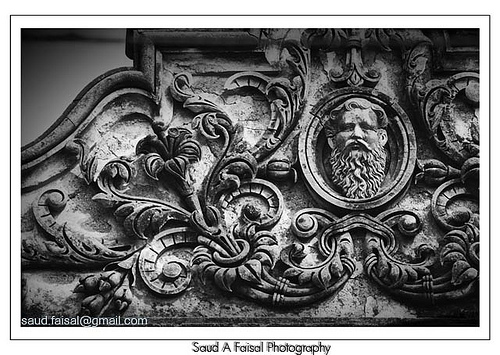 UNIT
1
UNIT
1
Warming Up
1. When did the Gothic style appear?
2. What are the characteristic features of this style?
3. Where did the Gothic style flourish?
4. Why is this style called Gothic?
5. What famous buildings of this style do you know?
G othic: engineered for heaven
If ever architecture expressed spiritual ideals, it would be in the lofty Gothic structures of medieval Europe and Great Britain. From the remarkable Saint-Denis in France to the Alteneuschule Synagogue in Prague, Gothic was a style that humbled man and glorified God. Yet, with its innovative engineering, the style was a testament to human ingenuity.
The earliest complete Gothic structure is the ambulatory of the abbey of Saint-Denis in France. Built between 1140 and 1144, the church became a model for most of the late 12th-century French cathedrals, including those at Chartres and Senlis. However, features of the Gothic style are found in earlier buildings in Normandy and elsewhere.
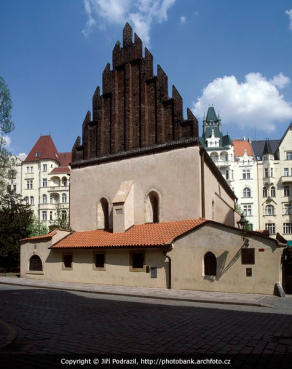
Gothic architecture is usually associated with Christianity, but the style became so predominant that builders routinely used Gothic ideas for all types of religious structures. Constructed in 1279, Prague's Old-New Synagogue was an early example. The small building features a classic Gothic roofline and eye-lid windows. Gothic and Renaissance design combine in the interior. Also known by the names Staronova and Alteneuschule, the Old-New Synagogue has survived wars and other catastrophes to become the oldest surviving synagogue in Europe.
S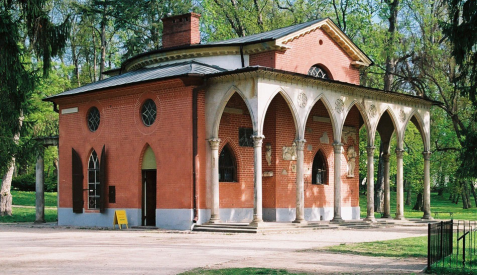
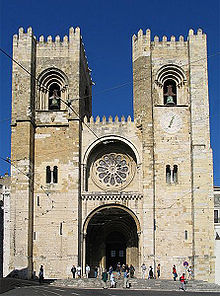 ecular
buildings also took on Gothic forms. The style found expression in
town halls, royal palaces, courthouses, hospitals, castles, bridges
and fortresses. However, in medieval days, most building was done for
and by the church, and the bold new ideas of Gothic design proved to
be especially suited for religious celebration and prayer. Medieval
man considered himself an imperfect reflection of the divine light of
God, and Gothic architecture was the ideal expression of this view.
New techniques of construction permitted buildings to soar to amazing
new heights, dwarfing anyone who stepped inside. Moreover, the
concept of divine light was suggested by the airy quality of Gothic
buildings, which were much lighter than churches in the earlier
Romanesque style.
ecular
buildings also took on Gothic forms. The style found expression in
town halls, royal palaces, courthouses, hospitals, castles, bridges
and fortresses. However, in medieval days, most building was done for
and by the church, and the bold new ideas of Gothic design proved to
be especially suited for religious celebration and prayer. Medieval
man considered himself an imperfect reflection of the divine light of
God, and Gothic architecture was the ideal expression of this view.
New techniques of construction permitted buildings to soar to amazing
new heights, dwarfing anyone who stepped inside. Moreover, the
concept of divine light was suggested by the airy quality of Gothic
buildings, which were much lighter than churches in the earlier
Romanesque style.
Structures in Romanesque style often included pointed arches, but builders of the day did not capitalize on the advantages of this shape. Gothic builders discovered the amazing strength and stability of pointed arches. In Gothic buildings, the weight of the roof was supported by the arches rather than the walls. This meant that walls could be thinner.
Romanesque churches relied on barrel vaulting. Gothic builders introduced the dramatic technique of ribbed vaulting. While barrel vaulting carried weight on continuous solid walls, ribbed vaulting used columns to support the weight. The ribs also delineated the vaults and gave a sense of unity to the structure.
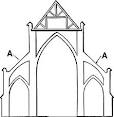 In
order to prevent the outward collapse of the arches, Gothic
architects began using a revolutionary "flying buttress"
system. Freestanding brick or stone supports were attached to the
exterior walls by an arch or a half-arch.
In
order to prevent the outward collapse of the arches, Gothic
architects began using a revolutionary "flying buttress"
system. Freestanding brick or stone supports were attached to the
exterior walls by an arch or a half-arch.
Since the walls themselves were no longer the primary supports, Gothic buildings could include large areas of glass. Huge stained glass windows and a profusion of smaller windows created the effect of lightness and space.
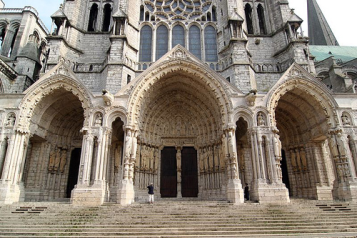
C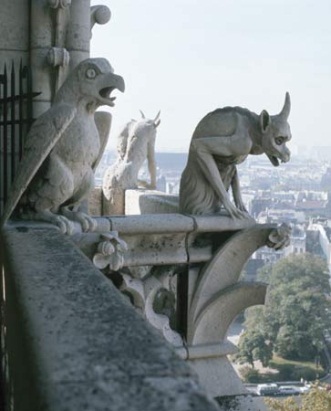 athedrals
in the High Gothic style became increasingly elaborate. Over several
centuries, builders
added towers, pinnacles and ornamentation to the lavish Chartres
Cathedral. More than 2000 sculpted figures decorate Chartres.
athedrals
in the High Gothic style became increasingly elaborate. Over several
centuries, builders
added towers, pinnacles and ornamentation to the lavish Chartres
Cathedral. More than 2000 sculpted figures decorate Chartres.
In addition to religious figures, many Gothic cathedrals are heavily ornamented with strange, leering creatures. These gargoyles are not merely decorative. Originally, the sculptures were waterspouts to protect the foundation from rain. Since most people in medieval days could not read, the carvings took on the important role of illustrating lessons from the scriptures.
Gothic buildings were based on the traditional plan used by basilicas. However, single units were inte¬grated into a unified spatial scheme.
Gothic architecture reigned for 400 years. It spread from northern France, swept throughout England and Western Europe, crept into Scandinavia and Central Europe, and even found its way into the Near East. However, the 14th century brought a devastating plague and extreme poverty. Building slowed, and by the end of the 1400s, Gothic architecture was replaced by other styles.
Scornful of exuberant, excessive ornamentation, artisans in Renaissance Italy compared medieval builders to German "Goth" barbarians from earlier times. Thus, after the style had faded from popularity, the term "Gothic" was coined.
However, Gothic ideas never completely vanished. During the nineteenth century, builders in Europe, England and the United States borrowed medieval traditions to create an eclectic Victorian style Gothic Revival. Even small private homes were given arched windows, lacy pinnacles and an occasional leering gargoyle.
Active Vocabulary
lofty – возвышенный, величественный humbled – смиренный, бедный, простой innovative – новаторский testament – завет, завещание ingenuity – изобретательность ambulatory – галерея для прогулок predominant – преобладающий, доминирующий secular – светский imperfect – несовершенный divine – божественный to soar – возвышаться, подниматься to dwarf – затмевать, подчеркивать незначительность to capitalize – капитализировать barrel vaulting – цилиндрический свод
|
ribbed – ребристый to delineate – изображать pinnacle – шпиц, бельведер lavish – щедрый, обильный gargoyle – горгулья waterspout – водосточная труба carving – резьба по дереву scripture – священное писание basilica – базилика spatial – пространственный devastating plague – опустошающая чума scornful – насмешливый, презрительный exuberant – обильный, пышный, богатый to vanish – исчезать, пропадать leering – зловещий, злобный |
TASKS
